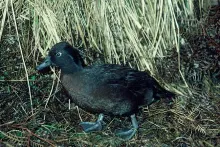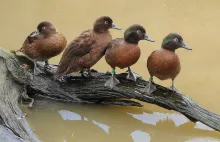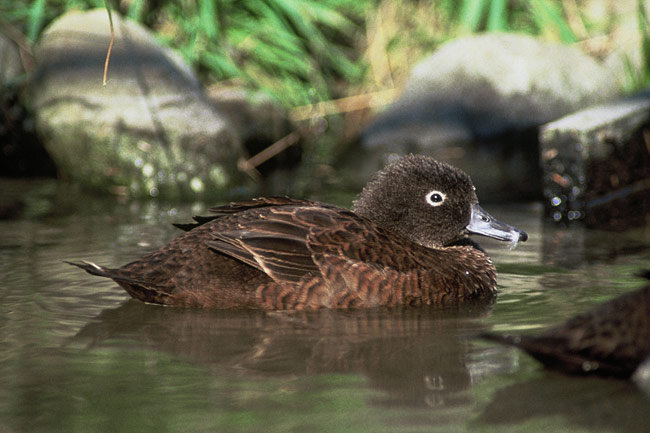
Campbell Teal (Anas nesiotis)
Species name
- Dutch name:
- Campbells taling (Niet-vliegende)
- English name:
- Campbell Teal
- German name:
- Campbellente
- French name:
- Sarcelle de Campbell
- Scientific name:
- Anas nesiotis
Scientific classification
- Order:
- Anseriformes
- Family:
- Anatidae
- Onderfamilie:
- Anatinae
- Genus:
- Anas
Description
- Description:
Male:
Brown eclipse male. Small, flightless, dark brown duck. Mottled dark brown breast. Prominent white eye-patch. Breeding male has glossy green head. Very narrow white collar, flank patch. Breeding males are a dark sepia colour, with strong green iridescence on their head, neck and back, dark chestnut tones on the breast, and lighter plumage on the abdomen, in addition to a conspicuous white ring around the eye and obvious white tail spot. During non-breeding plumage, the iridescence on the head and back becomes less intense, the tail spot becomes indistinct and the eye ring becomes pale fawn.Female:
Are uniformly dark brown with a paler abdomen, and prominent white eye ring.Juvenile:
Standard Measurements
- The male (drake) of the Campbell Teal measures approximately centimeters. The female measures approximately centimeters.
- The male will weight about gram. The female will weight about gram.
The weight is notoriously variable and can only be used as indication!
- Note:
Captive breeding of the Campbell teals was initially very difficult to achieve, as no studies on the behaviour of the species had been carried out in the wild and "staff [at Mount Bruce] thus had to experiment with a range of techniques to encourage breeding. Success came in 1994 when Daisy, the only wild origin female to ever lay eggs in captivity, finally accepted a mate. Subsequently, breeding has occurred every year – wild origin males contributed genes by pairing with captive raised females."
A tiny population of 25 captive-bred individuals was released on Codfish Island in 1999 and 2000, already intensively managed and pest-free as an important habitat for the critically endangered kakapo. In the final phase of the ecological restoration of Campbell Island (cattle, sheep and cats had already been removed), the world's largest rat eradication campaign was undertaken by helicopter drops of more than 120 tonnes of poisoned bait over the entirety of the island's 11,331 hectare area in 2001; this operation successfully removed what was estimated to be the world's densest population of Norway rats (200,000) from Campbell Island and it was officially declared rat free in 2003. Fifty Campbell teal, a mix of captive-bred and wild-acclimatised animals (from Codfish), were reintroduced to Campbell Island in mid-2004, after an absence of more than a century. Subsequent monitoring in 2005 has shown that the majority of these birds are now thriving in their ancestral homeland. By 2011 the species has firmly been returned to Campbell Island, resulting in a reclassification of its threat status to Endangered.
- Breeding:
- The female Campbell Teal usually lays from eggs and incubates them for days.
- Artificial incubating:
The ideal relative humidity for incubating most waterfowl eggs is 55% (ground nesters) and 40% (cavity nesters). The temperature is usually 37.4°C. Set ventilation as recommended by the incubator manufacturer. Eggs must be turned, either automatically or by hand, a minimum of 4 times a day. As the duckling develops there is a loss of water from the egg and the air sac gets bigger. In normal development of an egg with a days incubation, the air sac occupies about a third of it three days earlier. Cleanliness is vital and ideally eggs should be moved to a separate hatcher at this point, where the humidity should be increased to 65% and even higher once they have pipped internally.
- Bird banding:
- Recommended closed leg band ring size for the Campbell Teal is 9 mm.The leg band ring can only be applied on a young small, flightless dabbling duck at around 10-11 days old.
- It doesn't matter what leg that you band, but it's good to have a consistent system. Suggested: Left leg = Female, Right leg = Male
- Maintenance food:
-



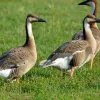

Lundi Regular with a protein content of 20%, valuable Spirulina and high-quality by-products is optimally balanced in its composition maintenance food for water ornamental fowl of all kinds. Especially green teal and Whistling ducks that are not dependent on a very high protein content, are well supplied.
Lundi Regular contains all the minerals and vitamins in full form that are important for the animals. Therefore also suitable as breeding food.


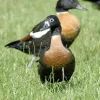


Floating full food for all sea ducks, green ducks, eider ducks and geese, especially in the moulting and breeding phase ideally suited. Packed with wholesome raw materials, natural vitamins and trace elements, this performance food with a protein content of 30% forms the basis for lifelong vitality.
